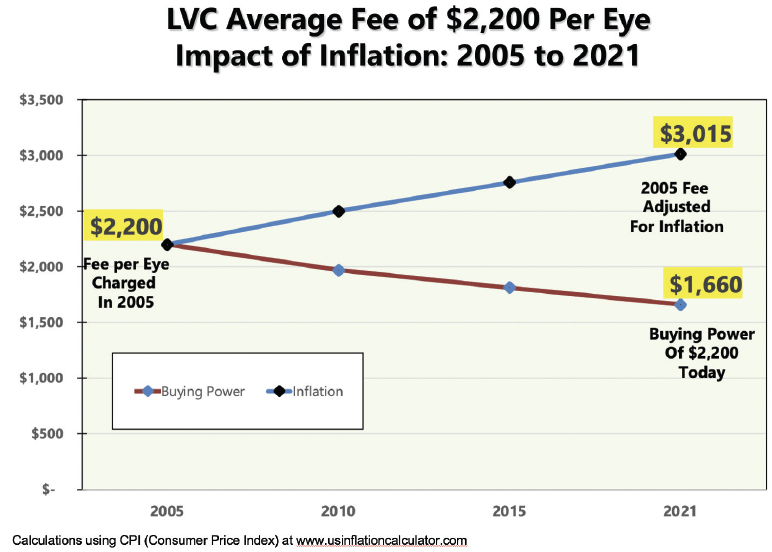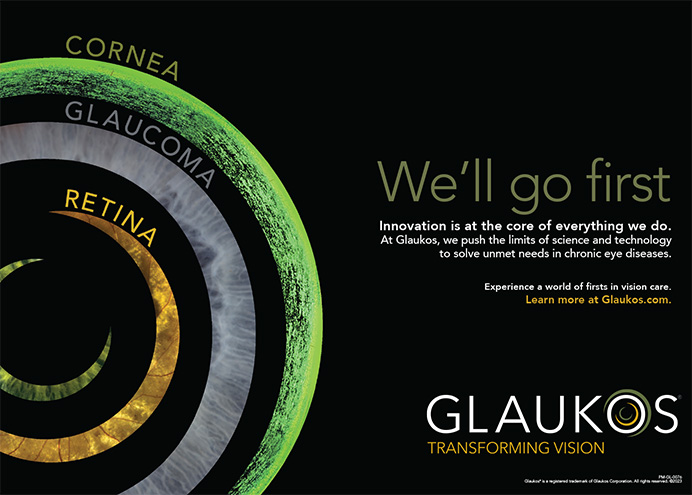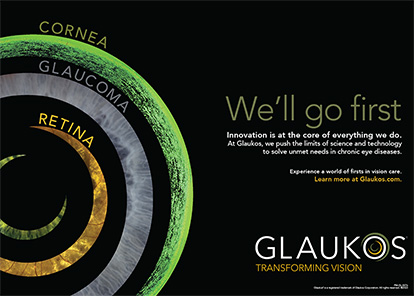
Ophthalmology is truly blessed, having both the most commonly performed surgical procedure (cataract surgery) and the most commonly performed elective surgical procedure (laser vision correction; LVC). I have reported on trends in elective procedures in CRST starting with the publication’s debut issue. Over the years, several of my articles have explored the relationship between price, demand, and value in refractive surgery. My main message at that time was that surgeons were undervaluing their services relative to the benefits the procedure offered. To put it bluntly, I advised them to stop discounting because it did not increase demand and was affecting perceived value by the public negatively.
Consumer research also indicated that most individuals didn’t want cheap surgery. When LVC prices were lowered between 2000 and 2002, demand dropped, the category gave up $1.7 billion in revenue, and refractive surgeons lost an average of $335,000 in net income.1
Since that time, prices have stabilized while demand has fluctuated. LVC surgical volume is still far below its peak. Today, a quarter of a century after the first FDA approvals for LVC, there’s another message that needs to be delivered: It’s time to raise your fees.
BACKGROUND
The initial approvals of the Visx (now Johnson & Johnson Vision), Summit (acquired by Alcon), and Bausch + Lomb excimer lasers came after a decade’s worth of research and clinical trials. The evolution of LVC from PRK to LASIK created an immediacy of result that resonated with consumers.
The introduction of femtosecond lasers for flap creation in the early 2000s improved the safety and public perception of LASIK. LVC outcomes today are typically far superior to what could be achieved when I underwent PRK, in Vancouver, Canada, in 1995.
Having led the marketing team at Visx during the company’s US launch in the mid-to-late 1990s, I was able to observe how surgeons and practices established their fees. The need to recover high fixed costs (the laser and its maintenance) and variable costs (procedural fees, marketing, and staff) led many practices to price LASIK at approximately $2,000 per eye. Ongoing surveys of ophthalmic surgeons by Market Scope around that time estimated that the average fee for LASIK ranged from $1,900 to $2,100 per eye. In 2000, according to Market Scope, the average fee dropped to $1,750 per eye, and it continued to decline to about $1,600 per eye in 2002.1
Unlike reimbursed health care, demand for refractive surgery is driven entirely by the market. As a result, manufacturers and surgeons have an incentive to improve technology and outcomes in order to expand the pool of LVC candidates and overall market demand.
Numerous additional indications for LVC have been granted in the United States. Demand, however, has not followed. The number of annual procedures is well below the peak of 1.4 million eyes treated between 2000 and 2007. The recent increase in demand fueled by the pandemic is a promising trend: Consumers don’t want to be wearing glasses with their masks.
Here are six reasons why surgeons are not charging enough for LVC and should consider increasing their fees.
Tenure and reputation. LASIK has stood the test of time. It has earned a reputation for quality outcomes and 98% customer satisfaction,2 far surpassing what has been achieved with contact lenses. Most consumers know someone who has undergone the procedure. More than 10 million people have undergone LVC in the United States. Worldwide, that number is likely three to four times higher.
Fear remains the key barrier for eligible patients. I, however, expect the popularity of LASIK and PRK to hold steady for the foreseeable future. SMILE also has the potential to expand the entire LVC category. The somewhat less-invasive nature of this procedure will help more consumers become interested in LVC. Lastly, the expected FDA approval of the Evo Visian ICL (STAAR Surgical) will bolster the eligible pool of candidates who can benefit from surgical vision correction.
Advocacy groups are essential to category development and growth. We now have both the Refractive Surgery Council and the Refractive Surgery Alliance helping to better align the messaging about LVC to consumers from the professional community. Both groups are careful not to position refractive technologies against one another. Rather, these organizations work to build public acceptance of refractive procedures as an alternative to spectacles and contact lenses. Back when LASIK could be deemed new or experimental, it commanded a price point of $2,000 per eye. The fee charged today should be commensurate to the procedure’s proven track record and long-lasting result.
True costs. Many practices calculate the cost of offering LASIK improperly with a bottom-up approach. This approach combines a list of individual line items (eg, marketing, procedure royalty fees, consumables, maintenance, labor, facility allocation, capital equipment depreciation) to generate a per-case cost. In multispecialty practices that offer a wide range of ophthalmic services, it can be challenging and somewhat subjective to allocate shared resources properly. Depending on the age of the equipment, many practices calculate their costs to be around $1,000 per eye.
Unlike a bottom-up approach, which tends to underestimate true costs, a top-down analysis is more accurate. This approach takes your annual costs and divides them by the total number of cases performed that year. It should include all direct expenses and an allocation for the facility and staff.
In surveys of refractive practices we work with, the true cost ranges from $1,600 to $1,900 per eye. Part of this is attributed to external marketing budgets and upgraded facilities to attract self-pay consumers. Nonetheless, the cost to perform LASIK tends to rise, not fall, over time. If your fees have not increased, the result is eroding margins. As a rule of thumb, if costs represent 75% or more of your fee, it’s time to raise your price.
Margin analysis. One challenge with fee setting is deciding how to value services above the cost to perform them. In business terms, this entails setting a reasonable profit margin that ensures the fee is within financial reach for patients. One way to determine the right margin for your practice is to compare the good or service to alternative offerings. For refractive surgery, this means comparing your profit margin for LASIK against the profit margins for spectacles and contact lenses.
Spectacles and contact lenses typically produce gross profit margins (ie, revenue less the cost of goods) of about 60% and 50%, respectively. Although this doesn’t take into account revenue from the eye exam or labor cost to dispense a pair of glasses or contacts, these margins are higher than what is typically achieved in refractive surgery, especially considering per-case disposables and royalties on top of laser amortization and maintenance.
The benefits of refractive surgery as a permanent solution that a customer pays for once should be valued more highly than a temporary solution for which a consumer pays repeatedly. The situation is akin to buying versus renting vision. If the profit margins of refractive surgery were simply on par with those of corrective lenses, a range of $3,000 to $4,000 per eye would be justified.
The impact of inflation. Inflation is the erosion of the value of a unit of currency over time. For example, perhaps your practice charged $2,200 per eye for LASIK 15 years ago—a price that was above the industry average at that time. If this price has been adjusted adequately to keep up with inflation, your practice is currently charging at least $3,000 per eye. If the price has instead remained the same, inflation has eroded the purchasing power of that revenue; a fee of $2,200 in 2005 is worth only $1,660 today (Figure).

Figure. Inflation has a significant impact on the value of the dollar over time. From 2005 to 2021, cumulative inflation was 37%, and the decline in purchasing power of $1.00 was 25%.
Inflation has a true impact on profitability. In the United States, people tend to dismiss this impact because we’ve been in a low inflationary environment for almost an entire generation. As shown in the Table, the average fee for all forms of LVC has ranged from $2,000 to $2,200 for much of the past 25 years. Preliminary data from a survey conducted by Market Scope in Q1 showed an increase this year to $2,474 per eye (verbal communication with publisher of the Market Scope Newsletter). This statistic is encouraging. However, the Q1 average fee is still far below the $3,000 or more that would have to be charged to keep up with the rate of inflation.

Price and demand do not correlate. The period from 2000 to 2005 was one of great volatility in the average fees charged for LVC. The low point occurred in 2002 when average fees fell below $1,600 per eye. Under pressure from discount-focused corporate providers and encouraged by some laser manufacturers, many surgeons lowered their fees to boost consumer demand.
It was easy to assume that lowering prices would increase demand, but the opposite occurred. As average fees dropped by 20%, the total number of procedures also dropped by about 20%. Many in the industry attributed the decline in procedural volume to external events beginning with the bursting of the dotcom bubble and stock market crash in 2000 and extending to the 2001 recession, the tragedy of September 11 in that same year, and Hurricane Katrina in 2005. The market demand for another elective procedure, breast augmentation, tells a different story. During similar time periods, the demand for breast implants tripled as fees increased by approximately 30%.
In both breast augmentation and LASIK, the relationship between price and demand demonstrates what economists call inelasticity of demand. This term means that unit volume does not increase in response to a reduction in unit price. Conversely, an increase in price may lead to an increase in demand. This is what happened in refractive surgery when the introduction of customized ablations and femtosecond lasers forced doctors to increase their fees to help offset additional costs. Prices increased, and demand followed a similar trend.
Price and perception of quality do correlate. In general, consumers have long associated price and quality. Many people believe that the more expensive something is, the higher its quality. This is only perception, of course, but it is one worth considering when establishing fees. It makes intuitive sense to charge more for something that delivers the life-changing value of refractive surgery.
The static nature of LASIK fees over the past 2 decades is also a factor in the perception of quality. During this period, the prices of high-ticket items such as cars, houses, and other elective offerings have increased.3
The field of cosmetic dentistry offers a case in point. Some procedures in this specialty cost far more than refractive surgery—a smile makeover can easily run $20,000. These professionals are taught to review and adjust their fees regularly. As a result, cosmetic dentists make sure that their profit margins do not decrease as their costs increase. More importantly, an ongoing adjustment of their fees can maintain public perception of the quality of services. If LASIK fees don’t increase similar to other high-cost purchases, its being relatively cheaper may not be a good thing when consumers are conditioned to believe that more expensive means better quality.
CONCLUSION
LASIK is a medical procedure that has associated benefits and risks. It’s also an elective procedure that competes with other retail offerings vying for the consumer dollar. The pricing of retail offerings follows a different set of rules than what doctors are accustomed to in the traditional health care model.
The life-changing nature of allowing people to see without corrective lenses is a modern-day medical miracle that can benefit more than half of the population. Compare the cost of LVC with other similarly priced uses of discretionary income. You will likely conclude that few, if any, consumer purchases offer a similar benefit. Hopefully, this will allow you to increase your fees with confidence and attract even more patients to refractive surgery, many of whom will exclaim it’s the best money they’ve ever spent in terms of return on investment.
1. Mahdavi, S. Retail pricing in refractive surgery, part II. Cataract & Refractive Surgery Today. 2003;6:39-42.
2. LASIK called safest, most successful elective procedure in the world. Healio. November 10, 2017. Accessed October 5, 2021. https://www.healio.com/news/ophthalmology/20171110/lasik-called-safest-most-successful-elective-procedure-in-the-world
3. Mahdavi S. Retail pricing in refractive surgery, part III. Cataract & Refractive Surgery Today. 2005;11:82-86.




